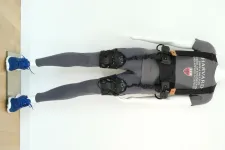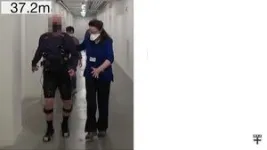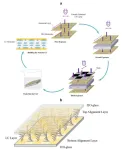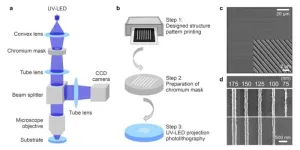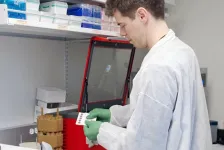(Press-News.org) EMBARGO: 05 January 2024 at 05:00 (US Eastern Time)
Freezing is one of the most common and debilitating symptoms of Parkinson’s disease, a neurodegenerative disorder that affects more than 9 million people worldwide. When individuals with Parkinson’s disease freeze, they suddenly lose the ability to move their feet, often mid-stride, resulting in a series of staccato stutter steps that get shorter until the person stops altogether. These episodes are one of the biggest contributors to falls among people living with Parkinson’s disease.
Today, freezing is treated with a range of pharmacological, surgical or behavioral therapies, none of which are particularly effective.
What if there was a way to stop freezing altogether?
Researchers from the Harvard John A. Paulson School of Engineering and Applied Sciences (SEAS) and the Boston University Sargent College of Health & Rehabilitation Sciences have used a soft, wearable robot to help a person living with Parkinson’s walk without freezing. The robotic garment, worn around the hips and thighs, gives a gentle push to the hips as the leg swings, helping the patient achieve a longer stride.
The device completely eliminated the participant’s freezing while walking indoors, allowing them to walk faster and further than they could without the garment’s help.
“We found that just a small amount of mechanical assistance from our soft robotic apparel delivered instantaneous effects and consistently improved walking across a range of conditions for the individual in our study,” said Conor Walsh, the Paul A. Maeder Professor of Engineering and Applied Sciences at SEAS and co-corresponding author of the study.
The research demonstrates the potential of soft robotics to treat this frustrating and potentially dangerous symptom of Parkinson’s disease and could allow people living with the disease to regain not only their mobility but their independence.
The research is published in Nature Medicine.
For over a decade, Walsh’s Biodesign Lab at SEAS has been developing assistive and rehabilitative robotic technologies to improve mobility for individuals’ post-stroke and those living with ALS or other diseases that impact mobility. Some of that technology, specifically an exosuit for post-stroke gait retraining, received support from the Wyss Institute for Biologically Inspired Engineering, and was licensed and commercialized by ReWalk Robotics.
In 2022, SEAS and Sargent College received a grant from the Massachusetts Technology Collaborative to support the development and translation of next-generation robotics and wearable technologies. The research is centered at the Move Lab, whose mission is to support advances in human performance enhancement with the collaborative space, funding, R&D infrastructure, and experience necessary to turn promising research into mature technologies that can be translated through collaboration with industry partners.
This research emerged from that partnership.
“Leveraging soft wearable robots to prevent freezing of gait in patients with Parkinson’s required a collaboration between engineers, rehabilitation scientists, physical therapists, biomechanists and apparel designers,” said Walsh, whose team collaborated closely with that of Terry Ellis, Professor and Physical Therapy Department Chair and Director of the Center for Neurorehabilitation at Boston University.
The team spent six months working with a 73-year-old man with Parkinson’s disease, who — despite using both surgical and pharmacologic treatments — endured substantial and incapacitating freezing episodes more than 10 times a day, causing him to fall frequently. These episodes prevented him from walking around his community and forced him to rely on a scooter to get around outside.
In previous research, Walsh and his team leveraged human-in-the-loop optimization to demonstrate that a soft, wearable device could be used to augment hip flexion and assist in swinging the leg forward to provide an efficient approach to reduce energy expenditure during walking in healthy individuals.
Here, the researchers used the same approach but to address freezing. The wearable device uses cable-driven actuators and sensors worn around the waist and thighs. Using motion data collected by the sensors, algorithms estimate the phase of the gait and generate assistive forces in tandem with muscle movement.
The effect was instantaneous. Without any special training, the patient was able to walk without any freezing indoors and with only occasional episodes outdoors. He was also able to walk and talk without freezing, a rarity without the device.
“Our team was really excited to see the impact of the technology on the participant’s walking,” said Jinsoo Kim, former PhD student at SEAS and co-lead author on the study.
During the study visits, the participant told researchers: “The suit helps me take longer steps and when it is not active, I notice I drag my feet much more. It has really helped me, and I feel it is a positive step forward. It could help me to walk longer and maintain the quality of my life.”
“Our study participants who volunteer their time are real partners,” said Walsh. “Because mobility is difficult, it was a real challenge for this individual to even come into the lab, but we benefited so much from his perspective and feedback.”
The device could also be used to better understand the mechanisms of gait freezing, which is poorly understood.
“Because we don’t really understand freezing, we don’t really know why this approach works so well,” said Ellis. “But this work suggests the potential benefits of a ’bottom-up’ rather than ’top-down’ solution to treating gait freezing. We see that restoring almost-normal biomechanics alters the peripheral dynamics of gait and may influence the central processing of gait control.”
The research was co-authored by Jinsoo Kim, Franchino Porciuncula, Hee Doo Yang, Nicholas Wendel, Teresa Baker and Andrew Chin. Asa Eckert-Erdheim and Dorothy Orzel also contributed to the design of the technology, as well as Ada Huang, and Sarah Sullivan managed the clinical research. It was supported by the National Science Foundation under grant CMMI-1925085; the National Institutes of Health under grant NIH U01 TR002775; and the Massachusetts Technology Collaborative, Collaborative Research and Development Matching Grant.
END
Soft robotic, wearable device improves walking for individual with Parkinson’s disease
Robotic exosuit eliminated gait freezing, a common and highly debilitating symptom
2024-01-05
ELSE PRESS RELEASES FROM THIS DATE:
Polarization-independent liquid-crystal phase modulators
2024-01-05
Liquid-crystal (LC) phase modulators are widely used in optical systems because of their advantages of low power consumption, light weight, flexible bandwidth adjustment, and non-mechanical movements. However, most LC phase modulators are polarization-sensitive, meaning that they affect the phase of light differently depending on its polarization. This can limit their performance and functionality in some applications.
There are two main approaches to realizing polarization-independent LC phase modulators. The first approach is to use polarization-independent ...
Low-cost microscope projection photolithography system for high-resolution fabrication
2024-01-05
Integrated optical signal distributing, processing, and sensing networks require the miniaturization of basic optical elements, such as waveguides, splitters, gratings, and optical switches. To achieve this, fabrication approaches that allow for high-resolution manufacturing are required. Curved elements like bends and ring resonators are especially challenging to fabricate, as they need even higher resolution and lower sidewall roughness. Additionally, fabrication techniques with precise control of absolute structure dimensions are imperative.
Several ...
Titan’s “magic islands” likely honeycombed hydrocarbon icebergs
2024-01-05
WASHINGTON — Titan’s “magic islands” are likely floating chunks of porous, frozen organic solids, a new study finds, pivoting from previous work suggesting they were gas bubbles. The study was published in Geophysical Research Letters, AGU’s journal for high-impact, short-format reports with immediate implications spanning all Earth and space sciences.
A hazy orange atmosphere 50% thicker than Earth’s and rich in methane and other carbon-based, or organic, molecules blankets Saturn’s largest moon, Titan. Its surface is covered with dark dunes of organic material and seas of liquid methane and ethane. ...
Historic urban Landscape Paradigm—A tool for balancing values and changes in the urban conservation process
2024-01-05
Today, for the first time in human history, more than half of the world’s population lives in cities. Coincidentally, within the field of cultural heritage conservation, increasing international interest and attention over the past two decades has been focused on urban areas. This is timely because the pressure for economic development and for the prioritizing of engagement with the global economy have accompanied rapid urbanization. In many societies, economic development has privileged modernization efforts leading to the loss of traditional communities. ...
UC Irvine engineers invent octopus-inspired technology that can deceive and signal
2024-01-05
Irvine, Calif., Jan 4, 2024 — With a split-second muscle contraction, the greater blue-ringed octopus can change the size and color of the namesake patterns on its skin for purposes of deception, camouflage and signaling. Researchers at the University of California, Irvine have drawn inspiration from this natural wonder to develop a technological platform with similar capabilities for use in a variety of fields, including the military, medicine, robotics and sustainable energy.
According to its inventors, new devices made possible by this ...
Classifying the natural history of asymptomatic malaria
2024-01-05
Detecting malaria in people who aren’t experiencing symptoms is vital to public health efforts to better control this tropical disease in places where the mosquito-borne parasite is common. Asymptomatic people harboring the parasite can still transmit the disease or become ill later, after initially testing negative.
The dynamic lifecycle of this pathogen means that parasite densities can suddenly drop below the level of detection — especially when older, less sensitive tests are used. Such fluctuations can make it difficult, when testing only at a single point in time, to determine if an apparently healthy person is in fact infected.
Malaria ...
New images reveal what Neptune and Uranus really look like
2024-01-05
Under embargo until 00:01 GMT on Friday 5 January 2024 /19:01 ET Thursday 4 January 2024
Royal Astronomical Society and University of Oxford press release
Neptune is fondly known for being a rich blue and Uranus green – but a new study has revealed that the two ice giants are actually far closer in colour than typically thought.
The correct shades of the planets have been confirmed with the help of research led by Professor Patrick Irwin from the University of Oxford, which has been published today in the Monthly Notices of the Royal Astronomical Society.
He and his team found that both worlds ...
Students build science identity through immersive research experience
2024-01-05
Each summer, community college students from Colorado and surrounding states converge on the CU Boulder campus to participate in an immersive nine-week research program. A recent CIRES-led study reveals that when the students head home, they don’t just take new scientific and professional skills with them—they also leave with more confidence in their ability to do science and a greater sense of belonging in the science community. The work, published last month in PLOS ONE, suggests that authentic research experiences inspire community college students’ interest in STEM careers.
“Paid, ...
Bipolar disorder linked to early death more than smoking
2024-01-04
Having bipolar disorder – a serious mental illness that can cause both manic and depressed moods – can make life more challenging.
It also comes with a higher risk of dying early. Now, a study puts into perspective just how large that risk is, and how it compares with other factors that can shorten life.
In two different groups, people with bipolar disorder were four to six times more likely as people without the condition to die prematurely, the study finds.
By contrast, people who had ever smoked were about twice as likely to die prematurely than those ...
Most babies with sickle cell disease face double disadvantage
2024-01-04
As if starting life with a potentially disabling genetic blood disease wasn’t enough, a study shows that almost two-thirds of babies born with sickle cell disease are born to mothers who live in disadvantaged areas.
But the study shows wide variation between states in the rate of births of babies with sickle cell to residents of areas with crowded housing, limited transportation options and other characteristics.
The researchers say their data could help public health authorities focus efforts to support the complex needs of children with sickle cell disease and their families.
The ...
LAST 30 PRESS RELEASES:
Space computing power networks: a new frontier for satellite technologies
Experiments advance potential of protein that makes hydrogen sulfide as a therapeutic target for Alzheimer’s disease
Examining private equity’s role in fertility care
Current Molecular Pharmacology achieves a landmark: real-time CiteScore advances to 7.2
Skeletal muscle epigenetic clocks developed using postmortem tissue from an Asian population
Estimating unemployment rates with social media data
Climate policies can backfire by eroding “green” values, study finds
Too much screen time too soon? A*STAR study links infant screen exposure to brain changes and teen anxiety
Global psychiatry mourns Professor Dan Stein, visionary who transformed mental health science across Africa and beyond
KIST develops eco-friendly palladium recovery technology to safeguard resource security
Statins significantly reduce mortality risk for adults with diabetes, regardless of cardiovascular risk
Brain immune cells may drive more damage in females than males with Alzheimer’s
Evidence-based recommendations empower clinicians to manage epilepsy in pregnancy
Fungus turns bark beetles’ defenses against them
There are new antivirals being tested for herpesviruses. Scientists now know how they work
CDI scientist, colleagues author review of global burden of fungus Candida auris
How does stroke influence speech comprehension?
B cells transiently unlock their plasticity, risking lymphoma development
Advanced AI dodel predicts spoken language outcomes in deaf children after cochlear implants
Multimodal imaging-based cerebral blood flow prediction model development in simulated microgravity
Accelerated streaming subgraph matching framework is faster, more robust, and scalable
Gestational diabetes rose every year in the US since 2016
OHSU researchers find breast cancer drug boosts leukemia treatment
Fear and medical misinformation regarding risk of progression or recurrence among patients with breast cancer
Glucagonlike peptide-1 receptor agonists and asthma risk in adolescents with obesity
Reviving dormant immunity: Millimeter waves reprogram the immunosuppressive microenvironment to potentiate immunotherapy without obvious side effects
Safety decision-making for autonomous vehicles integrating passenger physiological states by fNIRS
Fires could emit more air pollution than previously estimated
A new way to map how cells choose their fate
Numbers in our sights affect how we perceive space
[Press-News.org] Soft robotic, wearable device improves walking for individual with Parkinson’s diseaseRobotic exosuit eliminated gait freezing, a common and highly debilitating symptom
